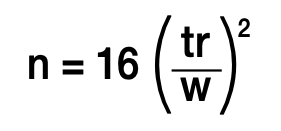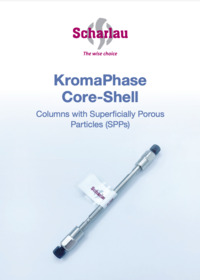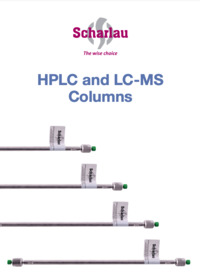Tips for Caring HPLC Columns
26 de May de 2025Tips for Caring HPLC Columns is extremely important for column longevity and the quality of HPLC analysis. Below are brief guidelines for the use, storage, and regeneration of HPLC columns.
1. Use of HPLC Columns
Silica is an ideal material for HPLC columns as it offers good mechanical stability, excellent surface physicochemical properties, a wide variety of functionalisation options, and compatibility with a broad range of organic solvents. However, the following points are crucial when working with silica-based columns.
pH Stability
In general, silica-based HPLC columns are stable within a pH range of 2 to 8. Buffer solutions with pH values above 8 hydrolytically attack the silica gel framework. Similarly, pH values below 2 also lead to hydrolytic processes, primarily resulting in the detachment of the surface coating of the bonded phase. “New generation” columns often allow for a wider pH range. For instance, KromaPhase C18 Scharlau columns support a pH range of 1 to 10.
Mechanical Stability
Silica-based stationary phases are mechanically very stable. Well-packed columns can be used at over 400 bar (6000 psi) without any issues. However, pressure shocks should be avoided as they can create preferential pathways in the column, potentially leading to peak splitting.
Sample Preparation
It is also crucial to filter the sample through a syringe filter before introducing it into the system. For columns with an internal diameter of 4 or 4.6mm, a 0.45μm filter is recommended. For columns with diameters of 3 or 2mm, a 0.2μm filter is preferable.
After use, the column should be washed, conditioned, removed from the system, and hermetically sealed.
Column Conditioning
The conditioning time of a column depends on its dimensions. Generally, a column is considered conditioned after passing 20 column volumes through it. The table below details the necessary conditioning times for the most common column sizes.
Mobile Phases (Eluents)
Silica-based HPLC columns are compatible with all organic solvents within the previously mentioned pH range. To achieve the best possible results, it is essential to use HPLC-grade solvents filtered to 0.45μm. Keep in mind that the column will accumulate all particles entering the system’s flow. The use of a pre-column significantly extends the column’s lifespan. Additionally, the pre-column filters out particles originating from the pump, injector, or sample itself. An alternative to the pre-column is an in-line filter placed between the column and the injector. Some buffer mixtures have extremely corrosive effects on stainless steel. Citrate, tartrate, and chloride ions should be avoided. Whenever possible, replace these with phosphate-based buffer mixtures as recommended in the instructions. This will also benefit the other HPLC system components. If working under unfavourable conditions is unavoidable, avoid leaving the column exposed to such eluents for prolonged periods. Buffer solutions should be flushed out with water as soon as possible, and the column should be reconditioned with a suitable solvent.
Column Dim. (mm) | Column Vol. (ml) | Flow Rate (ml/min) | Equilibration Time (min) |
250×4,6 | 2,91 | 1,00 | 58 |
150×4,6 | 1,74 | 1,00 | 35 |
100×4,6 | 1,16 | 1,00 | 23 |
50×4,6 | 0,58 | 1,00 | 12 |
250×4,0 | 2,20 | 1,00 | 44 |
125×4,0 | 1,10 | 1,00 | 22 |
250×2,0 | 0,55 | 0,25 | 44 |
150×2,0 | 0,33 | 0,25 | 26 |
50×2,0 | 0,11 | 0,25 | 9 |
To optimise conditioning, the flow rate can be halved while maintaining the 20 column volumes.
Frit Maintenance
After prolonged use, HPLC columns often experience pressure increases. In most cases, this is due to frit clogging. If this occurs, remove the column head and extract the frit. Replace the clogged frit with a new one. Used frits should not be reused. If necessary, clean them in an ultrasonic bath for 5 minutes in different solvents (e.g., heptane, THF, methanol, water). Different column designs, fittings, frit types, and placement systems exist.
Separation Capacity Check
If there is any doubt about whether a column still has sufficient separation capacity, it is advisable to check it using a “reference mixture.” The best comparison conditions are achieved using the same “reference mixture” used for the initial column test. The theoretical plate number can be calculated using the following formula:

2. Storage of HPLC Columns
HPLC columns are delivered pre-conditioned with a defined and pure mobile phase. The solvent used is indicated on the control chromatogram as the “eluent.” If a column is to be stored for an extended period, it should be conditioned with a defined, stable, and compatible mobile phase. For reverse-phase columns, methanol or acetonitrile with 20% water is recommended, while for normal-phase columns, hexane, heptane, or tetrahydrofuran are preferable. 100% water and buffer solutions are unsuitable due to the limited stability of silica gel, possible steel corrosion, and bacterial growth.

3. Column Regeneration
Sample impurities or mobile phase residues can become adsorbed at the column head, altering selectivity or causing peak splitting. This is also indicated by a significant increase in pressure under the initial mobile phase conditions. Often, these “dirty columns” can be regenerated using one of the following protocols:
Regeneration of Reverse Phase Packing Materials
Columns: C18, C8, C4, C1, C30, CN, and Phenyl
• Flush the column with 20 column volumes of water: ACN 50:50.
• Flush the column with 20 column volumes of acetonitrile.
• Flush the column with 5 column volumes of isopropanol.
• Flush the column with 20 column volumes of acetonitrile.
Regeneration of Normal Phase Packing Materials
Columns: Silica, Amino (if used in reverse phase with water, follow the RP packing regeneration protocol), Diol, and Nitro
• Flush the column with 20 column volumes of heptane.
• Flush the column with 5 column volumes of isopropanol.
• Flush the column with 20 column volumes of acetonitrile.
• Flush the column with 20 column volumes of heptane.
Regeneration of Ion-Exchange Columns
Anion- and cation-exchange columns (WCX, SCX, WAX, and SAX)
• Flush the column with 20 column volumes of the same eluent but with twice the buffer concentration.
• Follow the RP column regeneration protocol (see above).
• Flush the column with 20 column volumes of water.
• Equilibrate the column under the original operating conditions.
You may direct your enquiries or comments to: Scharlab Cromatography Division cromato@scharlab.com

 Philippines
Philippines





